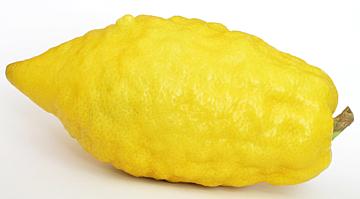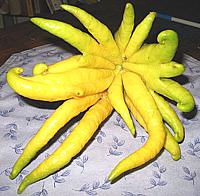 [Etrog (Hebrew), Citrus medica]
[Etrog (Hebrew), Citrus medica]
The Citron was the first citrus fruit brought to Europe, thus gave its name to the whole genus. Citrons can grow up to 6 inches long but are barely edible with a thick lumpy rind and what little flesh they may have is dry and full of seeds. The aromatic oils of its thick peel are widely used for flavoring drinks, perfumes, etc. The peel itself is often cut into strips and candied for use in making fruitcakes - also widely considered inedible.
The citron was known during Roman times, at first for medicinal purposes, to repel insects and as a perfume, but by the 2nd century CE it was being used in cooking as well. It is featured in the Hebrew holiday of Sukkot.
More on Citrus.

[Fingered Citron]
This mutation apparently originated in Northeastern India and is popular
as a curiosity. It has no seeds and no or very little juiceless flesh. The
rind is, as with other citrons, highly aromatic.
In the West the fingers are used as peel would be, but also can be thinly
sliced for salads and the like. The white pith is not bitter as it is in
most citrus so can be included with the yellow zest. In Asia it is used
to perfume rooms and personal items.
Photo by Voyou Desoeuvre distributed under
Creative
Commons v2.0 license.
ci_citronz 070222 - www.clovegarden.com
©Andrew Grygus - agryg@clovegarden.com - Photos
on this page not otherwise credited © cg1
- Linking to and non-commercial use of this page permitted